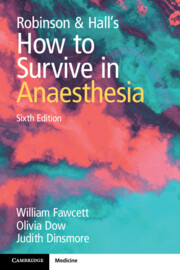Book contents
- Robinson & Hall’s How to Survive in Anaesthesia
- Robinson & Hall’s How to Survive in Anaesthesia
- Copyright page
- Contents
- Figures
- Tables
- Boxes
- Foreword
- Preface to the Sixth Edition
- Preface to the Fifth Edition
- Preface to the Fourth Edition
- Preface to the Third Edition
- Preface to the Second Edition
- Preface to the First Edition
- Abbreviations
- Let’s Start at the Very Beginning …
- Section 1 Nuts and Bolts
- Chapter 1 Evaluation of the Airway
- Chapter 2 Control of the Airway
- Chapter 3 Tracheal Intubation
- Chapter 4 The Difficult or Failed Intubation
- Chapter 5 Vascular Access
- Chapter 6 Pharmacology: A Brief Introduction
- Chapter 7 Intravenous Fluids
- Chapter 8 Anaesthetic Equipment: The Machine, Breathing Systems and Ventilators
- Chapter 9 Ultrasound in Anaesthesia and Intensive Care
- Chapter 10 Monitoring in Anaesthesia
- Chapter 11 Minimising Risk
- Section 2 Crises and Complications
- Section 3 Passing the Gas
- Section 4 Walking the Walk (and Talking the Talk)
- Section 5 And Finally …
- Index
Chapter 10 - Monitoring in Anaesthesia
from Section 1 - Nuts and Bolts
Published online by Cambridge University Press: 09 June 2025
- Robinson & Hall’s How to Survive in Anaesthesia
- Robinson & Hall’s How to Survive in Anaesthesia
- Copyright page
- Contents
- Figures
- Tables
- Boxes
- Foreword
- Preface to the Sixth Edition
- Preface to the Fifth Edition
- Preface to the Fourth Edition
- Preface to the Third Edition
- Preface to the Second Edition
- Preface to the First Edition
- Abbreviations
- Let’s Start at the Very Beginning …
- Section 1 Nuts and Bolts
- Chapter 1 Evaluation of the Airway
- Chapter 2 Control of the Airway
- Chapter 3 Tracheal Intubation
- Chapter 4 The Difficult or Failed Intubation
- Chapter 5 Vascular Access
- Chapter 6 Pharmacology: A Brief Introduction
- Chapter 7 Intravenous Fluids
- Chapter 8 Anaesthetic Equipment: The Machine, Breathing Systems and Ventilators
- Chapter 9 Ultrasound in Anaesthesia and Intensive Care
- Chapter 10 Monitoring in Anaesthesia
- Chapter 11 Minimising Risk
- Section 2 Crises and Complications
- Section 3 Passing the Gas
- Section 4 Walking the Walk (and Talking the Talk)
- Section 5 And Finally …
- Index
Summary
Monitoring is essential to safe anaesthesia and should be applied to any case wherever an anaesthetic is conducted. Safe monitoring of an anaesthetised patient includes the presence of a trained anaesthetist together with clinical and technical monitoring. Regular checking and maintenance of equipment should be undertaken. Safe monitoring aspects of the anaesthetic machine are emphasised in this chapter. Vital technical monitoring includes the use of electrocardiogram trace, pulse oximetry, respiratory rate, blood pressure and capnography. Depth of anaesthesia monitoring is discussed during the use of total intravenous anaesthesia (TIVA). Similarly, the use of neuromuscular monitoring is described as essential for patients who have received neuromuscular blocking drugs.
Specialised patient monitoring devices may be used in some cases, such as the use of invasive cardiac output monitoring, arterial or central venous pressures, neurological evoked potentials, or cerebral oximetry.
Keywords
Information
- Type
- Chapter
- Information
- Robinson and Hall's How to Survive in Anaesthesia , pp. 62 - 70Publisher: Cambridge University PressPrint publication year: 2025
Accessibility standard: Inaccessible, or known limited accessibility
Why this information is here
This section outlines the accessibility features of this content - including support for screen readers, full keyboard navigation and high-contrast display options. This may not be relevant for you.Accessibility Information
Content Navigation
Allows you to navigate directly to chapters, sections, or non‐text items through a linked table of contents, reducing the need for extensive scrolling.
Provides an interactive index, letting you go straight to where a term or subject appears in the text without manual searching.
Reading Order & Textual Equivalents
You will encounter all content (including footnotes, captions, etc.) in a clear, sequential flow, making it easier to follow with assistive tools like screen readers.
Visual Accessibility
You will still understand key ideas or prompts without relying solely on colour, which is especially helpful if you have colour vision deficiencies.
Structural and Technical Features
You gain clarity from ARIA (Accessible Rich Internet Applications) roles and attributes, as they help assistive technologies interpret how each part of the content functions.
